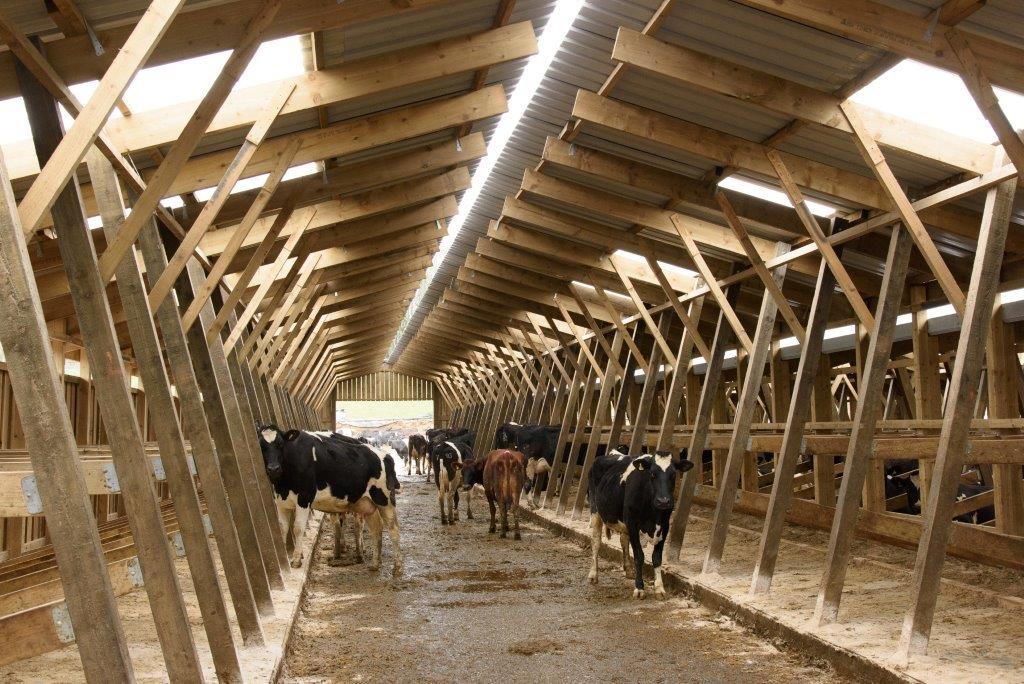Clean air in, stale air out
When we talk about ventilation, what does that actually mean? It is not simply the volume of air in a building, it is actually the rate of air exchange.
But let’s go go back to the beginning, and to do so we have to look at what animals do when exposed to nature and consider their rate of survival when left to the elements. Some modern breeds would find it very difficult to live outside all year and cope with the vagaries of our weather systems.
Animals out in the open will always look for nature’s shelters, just as humans must do in order to survive. We will always look for simple shelter wherever it can be found. Water, shelter from the elements and food are indeed, the main priorities for survival.
On a blustery, wet day, it is unlikely that you would choose to stand talking to someone in the middle of your farmyard. You are much more likely going to move and stand around the corner of a building to shelter from the wind and rain, of course.

SHELTER & SHADE
Similarly, when the sun is on full power, it is important to find shade. Animals in the natural environment always try to find shelter in the most basic form, whether from sun, rain or winds. They use hedges, walls and natural hollows to get out of or reduce the impact of the winds. They use trees for shade. So, taking a leaf from nature, when we look at buildings we need to stick to the basic principles of nature. All animals want shelter from the wind and rain, shade from the sun and plenty of fresh air. Air movements ideally should be above animal height so as not to create a draft. There are very few days in a year that we, as humans, are glad of a small breeze.
We are much more likely to be concerned about the chilling effect of the wind and say it would be better if the wind dropped, and animals are no different – they need shelter from those draughty chilling winds as well. All animals need a shelter wall to be able to lie behind with a decent air gap above for air to pass over. Depending on the height of the wall, the gap above may need some wind break material above it to break wind speed on bad days.
When designing buildings, we need to consider all the factors. The main factor for livestock buildings is the actual purpose of the building. Is it for Adult Cattle, Yearlings, Young Calves or even Sheep? Whichever group, they will all have different needs regarding optimum sizes and feeding systems. There are many guide lines on volume of air per animal, but the best form of ventilation is and probably always will be, natural ventilation with gaps at the eaves and open ridges. This will undoubtedly also be the cheapest form of ventilation you can get, no fans using electricity, no moving parts and thus nothing to go wrong.
In high rainfall areas, where there is concern about open ridges, special cappings can be applied. The best answer is still simple, upturned flashing to make the outside air lift over the ridge of the roof, yet most people don’t fit the flashings correctly. The big temptation is always to try and close the gap up with these flashings and consequently, the base of the upstand ends up being further up the roof than the end of the roof sheet. This doesn’t work and leads to a lot more problems as rainfall hits the insides, runs down and drips off the base corner – and it feels as though it is raining in. The base of any upstand should always be at a minimum 50mm (two inches) back from the top of the roof sheet, so that any water/rainfall that hits the inside of the upright flashing can then drain away. Let’s face it, it is very rare that rainfall comes straight down – it nearly always comes down at an angle so then it will hit the inside of any upturned flashing, run down to the bottom edge and as long as that edge is back from the top of the sheet it will run down the roof to the gutter. If you double the volume of air in a building then realistically you need to double the size of the openings at the eaves and ridge.

DESIGNED FOR YOUR LIVESTOCK
People often have one side of a building open and think that will be fine, there is plenty of space for the air to get out. After buying a smoke machine for testing buildings a few years ago, it really opened my eyes to how ill-informed most of us are regarding air flows. The best I saw was in an old building in which I could barely stand up. it had a small gap under 24/07/2017 10:06 the gutter and an open ridge. Within 30 seconds the smoke had gone completely! Yet in a single slope open shed it took approximately five whole minutes to go and when it did, the smoke went out through the low side. The wider buildings become a greater problem arises with stale air, because the air has to travel much further to get to the ridge and often the stale air cools and comes back down again. From my experience, lower buildings are much easier to get natural air flow working.
You really do need to design your buildings for the animals that use them, not the big machines you like to play with. In reality, we have been constructing bigger, taller buildings for the last 10 years and now nearly all the farmers have had to buy fans to try and get air to move. Most of these fans are only trying to move the air, they aren’t blowing clean air in or extracting stale air out. This must validate the simple truth that volume of air is not enough in itself. Air exchange is what is needed: simply clean air in and stale air out.
Jim Rogerson and his team at Farmplus Construction have really perfected what could be described as the” Ultimate” of Timber buildings for Livestock incorporating – Eco design – Comfort – Health and wellbeing all at a very reasonable cost – Call them today to discuss your requirements.






